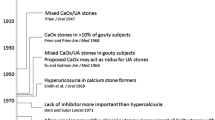Abstract
Nearly one-third of patients with calcium stones have hyperuricosuria. In vitro studies and clinical trials have investigated the relationship between uric acid and calcium stones, but the association between hyperuricosuria and calcium stone formation in patients is still being debated. Uric acid appears to cause salting out of calcium oxalate in human urine. However, the importance of this in vitro phenomenon to the proposed association is not supported in cross-sectional observational studies. A small placebo-controlled randomized clinical trial showed that allopurinol decreased the rate of recurrent calcium oxalate calculi in patients with hyperuricosuria and normocalciuria. An assessment of the effect of combination therapy of allopurinol with indapamide showed no additive effect. Allopurinol may have antioxidant effects that are responsible for its reducing calcium stone formation, which are independent of xanthine oxidase inhibition. In addition, a newer xanthine oxidoreductase inhibitor, febuxostat, may also be effective in the prevention of calcium stones, as it reduces urinary uric acid excretion.

Similar content being viewed by others
References
Coe FL (1977) Treated and untreated recurrent calcium nephrolithiasis in patients with idiopathic hypercalciuria, hyperuricosuria, or no metabolic disorder. Ann Intern Med 87(4):404–410
Grover PK, Marshall VR, Ryall RL (2003) Dissolved urate salts out calcium oxalate in undiluted human urine in vitro: implications for calcium oxalate stone genesis. Chem Biol 10(3):271–278
Ettinger B, Tang A, Citron JT, Livermore B, Williams T (1986) Randomized trial of allopurinol in the prevention of calcium oxalate calculi. N Engl J Med 315(22):1386–1389
Lonsdale K (1968) Epitaxy as a growth factor in urinary calculi and gallstones. Nature 217(5123):56–58
Coe FL, Lawton RL, Goldstein RB, Tembe V (1975) Sodium urate accelerates precipitation of calcium oxalate in vitro. Proc Soc Exp Biol Med 149(4):926–929
Grover PK, Ryall RL, Marshall VR (1993) Dissolved urate promotes calcium oxalate crystallization: epitaxy is not the cause. Clin Sci (Lond) 85(3):303–307
Grover PK, Ryall RL, Marshall VR (1992) Calcium oxalate crystallization in urine: role of urate and glycosaminoglycans. Kidney Int 41(1):149–154
Grover PK, Ryall RL, Marshall VR (1990) Effect of urate on calcium oxalate crystallization in human urine: evidence for a promotory role of hyperuricosuria in urolithiasis. Clin Sci (Lond) 79(1):9–15
Grover PK, Ryall RL (2005) Comment on epitaxial relationships between uric acid crystals and mineral surfaces: a factor in urinary stone formation. Langmuir 21(23):10898
Curhan GC, Taylor EN (2008) 24-h uric acid excretion and the risk of kidney stones. Kidney Int 73(4):489–496
Ettinger B (1989) Does hyperuricosuria play a role in calcium oxalate lithiasis? J Urol 141(3 Pt 2):738–741
Borghi L, Meschi T, Guerra A, Novarini A (1993) Randomized prospective study of a nonthiazide diuretic, indapamide, in preventing calcium stone recurrences. J Cardiovasc Pharmacol 22(Suppl 6):S78–S86
George J, Carr E, Davies J, Belch JJ, Struthers A (2006) High-dose allopurinol improves endothelial function by profoundly reducing vascular oxidative stress and not by lowering uric acid. Circulation 114(23):2508–2516
Stoller ML, Meng MV, Abrahams HM, Kane JP (2004) The primary stone event: a new hypothesis involving a vascular etiology. J Urol 171(5):1920–1924
Ferraro PM, Taylor EN, Eisner BH et al (2013) History of kidney stones and the risk of coronary heart disease. JAMA 310(4):408–415
Joshi S, Peck AB, Khan SR (2013) Nadph oxidase as a therapeutic target for oxalate induced injury in kidneys. Oxid Med Cell Longev 2013:462361
Goldfarb DS, Macdonald PA, Gunawardhana L, Chefo S, McLean L. Randomized controlled trial of febuxostat versus allopurinol or placebo in individuals with higher urinary uric acid excretion and calcium stones. Clin J Am Soc Nephrol 2013
Fink HA, Wilt TJ, Eidman KE et al (2013) Medical management to prevent recurrent nephrolithiasis in adults: a systematic review for an american college of physicians clinical guideline. Ann Intern Med 158(7):535–543
Conflict of interest
Arowojolu: none; Goldfarb: consultant, Takeda, Astra Zeneca; owner, Ravine Group; Honoraria: Mission Pharmacal.
Author information
Authors and Affiliations
Corresponding author
Rights and permissions
About this article
Cite this article
Arowojolu, O., Goldfarb, D.S. Treatment of calcium nephrolithiasis in the patient with hyperuricosuria. J Nephrol 27, 601–605 (2014). https://doi.org/10.1007/s40620-014-0084-x
Received:
Accepted:
Published:
Issue Date:
DOI: https://doi.org/10.1007/s40620-014-0084-x




